| RACING HISTORY |
YEAR: 2011
FEATURE RACE COMMENT
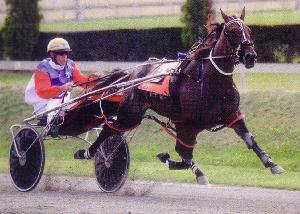 |
De Lovely had her first test against the open class pacers on Saturday at Addington and passed with flying colours.
Trailing all the way on a moderate tempo, De Lovely always looked like she would have the last say up the passing lane in the $25,000 United Fisheries Ltd Summer Cup - and so it proved, the Falcon Seelster mare zipping past the pacemaker Monkey King and Highview Tommy to win with something in hand.
"Monkey King was probably still a run short," conceded driver David Butcher. "I mean, you look in the book and Monkey King's won $3.4 million - at $580,000-odd, we're way behind. The only speed in the race came when Hghview Tommy loomed up at th 100m mark and had a look, that was it."
Butcher justified his driving tactics at De Lovely's previous start when she couldn't beat the mares, saying "I thought I could sit last and still pick them up. You've got to remember that it was her first start for five weeks. But they're not machines. Horses are so hard to manage sometimes, and the team at Wigram Lodge have obviously done a good job with her in the interim. She's beautiful to sit behind, because she's got such a lovely gait."
Trainer Ian Small and De Lovely's connections are pretty much adopting a 'take it as it comes' approach to the remainder of the season, because there's plenty of races like the Harness Jewels at Ashburton and Taylor Mile/Messenger in Auckland at her disposal without even thinking about the trans-Tasman battle at Addington which starts next month. "Inter-Dominions? We'll see," Butcher said. "We thought she'd have about eight races this season, and she's already had six."
Credit: John Robinson writing in HRWeekly 9Feb2011
YEAR: 2011
FEATURE RACE COMMENT
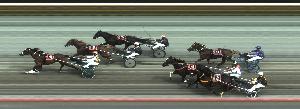 |
Master Bomber was back in the winners’ circle on Saturday at Addington when taking out the Group 3 United Fisheries Ltd Trotting FFA. With two wins under his belt this season, the Armbro Invasion-gelding closed as second favourite behind Dr Hook in the $25,000 race.
Master Bomber was one of the fastest off the gate with trainer-driver Gerard O’Reilly electing to head straight to the front for the 1950m trot. From there he was untouchable. Heading for home he charged in front of the field. Idid It Myway tried hard to cut him down, but could not close in fast enough, with Master Bomber winning by a length. Idid It Myway was second by a neck over stablemate Dr Hook, who had run on very well.
Master Bomber is owned by Hubert Christey and is now into his third season of racing. Saturday’s win was his first Group race and 10th lifetime win from 41 starts which includes this seasons’ Listed Ordeal Cup. The seven-year-old has earned $125,540 from these starts.
Credit: Harness Racing Website
YEAR: 2011
FEATURE RACE COMMENT
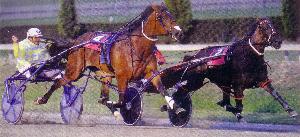 |
| De Lovely (inner) beating Nearea Franco |
Red-hot favourites usually win by more than a pencil line. So De Lovely gave those who backed her into $1.20 plenty of reasons to panic as she scraped home by the barest of margins at Addington on Friday night.
But don't blame De Lovely - point the finger at Nearea Franco, because she and Craig Thornley did such a sterling job of pacemaking in the $80,000 Group 1 PGG Wrightson NZ Breeders Stakes that they almost stole the unstealable. After all, just under a week earlier De Lovely had zoomed past the winner of our last two New Zealand Cups and won under a hold by nearly two lengths. Six days later she needed a good couple of cuts with the whip from David Butcher to nab Nearea Franco on the line. And only just got there.
The two great mares were clearly superior to their eight other rivals, proved in no uncertain terms by the seven and a half length margin back to Lancome in third place after torrid final sectionals of 56.2 and 27.5. But for De Lovely it'll go down as another victory in her brilliant career, the 15th time she's saluted in 24 appearances, good for nearly $650,000 in stakes for the Les Girls No.2 Syndicate who bred and race the 4-year-old daughter of Falcon Seelster and Copper Beach.
De Lovely's only defeat in 12 starts since May last year came in the Group 2 Premier Mares Championship on January 21, her third to Beaudiene Bad Babe that night denying her the chance to join Kiwi Ingenuity(2009), It's Ella(2007), Mainland Banner(2006), Coburg(2004), Kym's Girl(2000), Lento(1996), Blossom Lady(1993 & 1991), Gina Rosa(1989) and Bionic Chance(1988) on the coveted list of those who have won the two big Addington mares' features in the same season.
Credit: John Rpbinson writing in HRWeekly 16Feb 2011
YEAR: 2010
BUILDINGS & FACILITIES
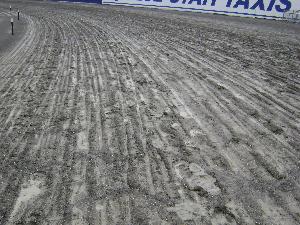 |
The Addington Raceway surface has been one of the most durable and consistent in the world over the last 30 years. For the first time in decades a meeting was called off (after the sixth race)at Addington Raceway last Friday night due to the state of the track after a day of rough weather.
Traditionally, the Addington track has remarkable drying and absorption qualities but on Friday night things were different. The writing was on the wall early when a false start was declared in the 2YO Non-Tote Trot due to the mobile gate being unable to gain satisfactory traction to clear the field at dispatch. Rolling starts ensued but the rain kept falling.
The track was awash, with drivers getting unusually muddy and visibility back in the fields being very limited. A meeting of senior horseman, Stipendiary Stewards and Addington officials after Race 6 resulted in the meeting being abandoned.
Addington Raceway CEO, Shane Gloury, offers a rundown of events. “Basically, it came down to abnormal and unusual rainfall that reacted differently with the track than the rain we are used to. We had two inches of swirling, misty drizzle that sat on top of the track rather than draining through it and down the surface toward the inside.
“There was talk that the track was ‘conditioned’ earlier in the day and week. That wasn’t the case. Our track manager John Denton prepared the track as if it was going to rain on race day. “Obviously, since last Friday night we’re looking at ways to ensure this doesn’t happen again.”
The Met club hasn’t shirked its obligation to owners over the abandonment, either. Connections of horses that did not get a run in races seven to 10 on Friday night, that haven’t already received a travel subsidy, will be compensated $100 per horse.
The Caduceus Club Mares’ Championship, for which Kiwi Ingenuity was hot favourite will now be run six days after the Breeders Stakes on February 18 and will coincide with the final day of the National Yearling Sales.
Credit: HRNZ 25Jan10
YEAR: 2010
SECRETARIES & EXECUTIVE STAFF
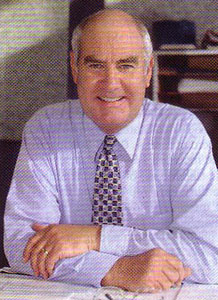 |
Tony Lye will be the first to admit he was the last of the rubber, pen and pencil men at Addington Raceway. After putting up stout resistance, he eventually made friends with the computer – well, sort of. But when the time came a fortnight back to give it one last click, there wasn’t much sorrow either way.
There are some old habits and patterns that come after doing much the same job for 36 years, and Lye knew he had them. For more than 20 years he was the efficient and super steady Racing Manager for the NZ Metropolitan Trotting Club, but tough times for the club has caused work casualties and Lye is one of them.
He is sad to leave a responsible job that he’s been very good at and widely respected in. “It’s fair to say that I think I’m going before my time” – he’s 60 – “but that’s the card I’ve been dealt,” he said.
Lye had the manual aspect of taking nominations and drawing up the fields down to a fine art, “but the computer changed it all. I was slow to react – I was a pencil, pen and rubber man. Why should I change? This is the way I’ve always done it. So it’s true to say I did resist it.”
This area is just one of many that Lye has seen change dramatically. What else?
“The development of Raceway land around the track, the building of the Westpac Centre, the new stabling complex, and the loss of the huge carparks which we needed for most of the meetings when we had fewer of them years ago. When you think of it, Addington Raceway was once the closest farm to the centre of the city”
Lye said when he started there were about 20 meetings a year between the three clubs – the Met, Canterbury Park and New Brighton – and a staff of eight.
“We had a card for every horse, about two hundred and fifty of them. All the details were typed in – owner, breeder, trainer, age, colours, and when a colt became a gelding we would pick the card out and turn the ‘c’ into a ‘g’. There was also a card with the last starts of each horse, and we would choose the fields from the form on the cards. Back then a raceday was a big day”
Cup Day was always the biggest day of the year, and Lye said it was never a difficult one if the preparations were properly made. “You’d hold your breath that everything went well, but it did because everyone stepped up.”
Lye has difficulty accepting the situation where some of the country clubs can pay higher stakes than a similar class at Addington. “That’s completely wrong. It should be an incentive for any owner or trainer to race at a metropolitan meeting and race for more money. I know quite a few like to take their picnics to other tracks, but it’s not as hard to win at Addington as it used to be. It’s an anomaly that is not right.”
Lye has seen handicapping systems come and go. This current one seems to be the flavour they want, and the concessions are a big part of it.”
Redundancy means something new ahead of him. I won’t miss the repetition, but I’ll miss going to the races, the day-to-day activity of the office, and the good staff they have there.”
Credit: Mike Grainger writing in HRWeekly 7Apr2010
YEAR: 2010
CARETAKERS
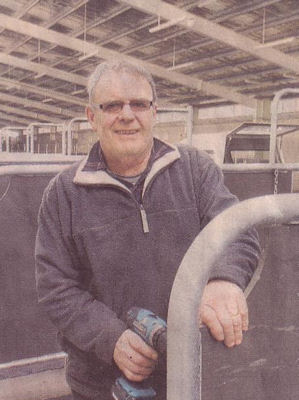 |
On Saturday night at the NZ Harness Racing Awards, Allan Maslin was named the 2010 ICE Bloodstock Unsung Hero.
Allan has worked at Addington Raceway for the past 18 years as the Addington Course Caretaker. Born and raised in Gore, Allan has had a lifetime interest in racing. He worked for trainer Ted Winsloe at Gore in his younger days although becoming a jockey wasn’t for Allan with weight quickly catching up with him in his developing years.
A cabinetmaker by trade, Allan moved to Christchurch as a young man and worked in this trade for many years. In 1992, an opportunity arose for Allan to become the Course Caretaker at Addington, an opportunity that he jumped at given his interest in racing. In the ensuing 18 years he has provided fantastic service to Addington Raceway.
Nothing ever fazes him no matter what the task or the situation that confronts him. He never complains no matter how difficult or dirty the task or the odd hours that at times are associated with his job. He is up early most mornings to open the gates to the Raceway at 5.30am. He churns through the various jobs: maintenance, plumbing, carpentry and other repair work that is required at Addington and is back on site to close the gates at the end of each night, which sometimes can be after midnight when a racemeeting or function takes place.
Allan was largely responsible for getting the stables completed and operational in 2009 after problems were encountered with the building contractor towards the end of the Stables Project. He was also instrumental in performing the interior work for the Garrards shop that operates on site at Addington and also built the new winning owners bar that opened recently. Allan plays a very important role in the lead up to Cup Day each year getting much of the temporary infrastructure in place to ensure that Cup Day runs successfully.
Allan attends all race meetings at Addington and is always on hand to fix any problems that may arise during the meeting. Whatever he does, he does with a smile and nothing is too big or too small or a burden to him.
Credit: HRNZ Website
YEAR: 2010
PEOPLE
PHIL COULSON
Phil Coulson, the man who caused the biggest sensation of all Interdominion Pacing Championship upsets at Addington in 1971, died this month. He protested to the last his innocence of the subsequent charges which earned him an unprecedented disqualification of seven years.
The Perth trainer-driver stole the Interdominion final with Junior's Image, suddenly rushing clear with 600m to run - a rare winning tactic at Addington - leaving his rivals flat-footed. He held on by a neck from Stella Frost to win the $26,000 first prize. Five days later it was announced the horse had a positive to caffeine and some months later it was disqualified along with Coulson.
Even in New Zealand there was disquiet over the case and Coulson's friends still point to his professionalism as the major argument against his conviction. "He was an absolutely meticulous horseman," recalls a Christchurch friend, Robert McArdle. "Everything in Phil's stables was immaculate, spotless. When he came to Addington he bought the horse a new feed bin because he didn't approve of Addington's ones and when the horse fretted a little over the trip he bought some pot plants and hung them around his stall. He could never have been sloppy enough to do what was claimed."
Coulson was no "wild west" horseman like some from his home state. He had won the 1967 Interdominion with Binshaw (his favourite horse) and only Frank and Fred Kersley won more driving and training premierships in Perth. He reined over 1000 winners and was an inaugural member of the West Australia Hall of Fame. He was the West Australian Sportsman of the Year in 1966.
"When a search was made of his stable area after the swab there were traces of the caffeine everywhere. As they said at the time it looked as though it had been sprinkled with a salt shaker. Nobody who knew how Phil operated would accept it could have been like that," McArdle said. McArdle and Aussie Eddie Sims had an option on Junior's Image going into the Interdominion and sold him to American Dunkin Donuts founder Bill Rosenberg, for whom he was a good winner.
Richard Trembath, a long time editor of the Australian Trotting Weekly, was another who never accepted the Junior's Image positive test. A good friend of Coulson, in 1978 he conducted a thorough investigation into the affair which he now describes as "a scandalous miscarriage of justice". The two-page feature which resulted helped earn him the annual Coulter Award for the best harness article of the year in Australia. "Phil always believed he had been set up. Some things I found out were disturbing. For example, the amount of caffeine found in the horse was very small. You could have got as much performance boost as from a cup of tea. A leading New Zealand horse won a Derby about the same time, returned only a slightly smaller dose, and the penalty? The trainer was fined $300 and the horse kept the race. One person on the committee (the hearing lasted three days) later admitted he nodded off listening to the evidence. There were a lot of question marks over the case and there still are."
Junior's Image would have been the first Australian-trained horse to win an Interdominion in New Zealand had he held the race. There were suggestions that agitation from people whose reputations might be affected by that played a role in the severe penalty handed down. "In the 40 years I covered Interdominions, Phil's drive was the best I saw from a tactical point of view," Trembath said. "In a single move he won the race. I am not saying Phil was a saint, but he would not have done some things with horses that were marginal, because the competition is such that most horsemen do at some time or another. But I would stake my life he would never have done it the way it was made out with the caffeine everywhere. It was just not his way. As a person he was a fine bloke. I was proud to call him a friend. He always assured me he had done nothing wrong with Junior's Image even years later when it didn't matter. But mud sticks and it is a shame many people over there only remember him because of the Junior's Image case."
Coulson, 77 when he died of cancer, served several years of his disqualification working on a crayfish boat off Perth in which he had an interest. Junior's Image was in fact the least able of many stars he either trained or drove. Coulson was credited by outstanding dual-gaited Perth horseman, Fred Kersley, as an "inspiation to my career".
Among the great horses Coulson trained, drove or both, were Village Kid, Gammalite and the mighty Pure Steel. His drive on Pure Steel in a famous match race with Satinover in Perth, when he used the champion's great stamina to wear down his brilliant rival, which had won 29 races in a row, was a highlight. Another was his drive on Village Kid to beat hot favourite Preux Chevalier in the West Australian Cup. The cup was Perth's equivalent of the New Zealand Cup and a race for which he prepared a record seven winners. Coulson was also credited with changing the style of racing in Perth with his introduction of the two and three-wide train and putting pressure on from the front after years of single file racing.
In spite of the Junior's Image affair, he was a popular personality and a hit with the media during his short stay in Christchurch. Some attempt was made by friends of Coulson here to review the case. Transcripts and evidence was gathered but it came to nothing. Coulson later said he did not fight the case personally (he stayed in Perth) because a story appeared in the Christchurch media before the evidence was heard. It said if he was not found guilty all the clubs in New Zealand would be up for the costs. So he was never going to get a fair hearing from then on.
Whatever the truth of that assertion and whatever the truth of the Junior's Image affair, the rest of Coulson's career proved he was indeed one of Australia's great harness horsemen.
Credit: David McCarthy writing in The Press 17 July 2010
YEAR: 2010
PEOPLE
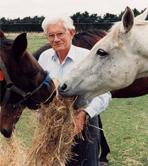 |
It seems odd that one honoured with such a long list of degrees and awards for outstanding work in several fields of equine medicine as Professor Cliff Irvine should rate his proudest thrill as winning the 1986 Dominion Handicap at Addington with Tussle. But it sums up the complxity of a rare personality - someone able to discuss the most involved aspects of equine reproduction at any university forum in the world, and yet just as happy chatting about training his horses with people who never went to secodary school.
Irvine died recently, soon after his 90th birthday. He was Emeritus Professor of Veterinary Science at Lincoln University, a Doctor of Science (Otago) - the highest award in his field in New Zealand - and had honorary doctorates from Massey and Sydney universities among a host of other national and international awards, including the Bledisloe Medal from Lincoln University. He had an insatiable appetite for research but he never lived in an ivory tower.
Born in Dunedin in 1920, Clifford Hugh Greenfield Irvine, never one to bow to authority, left Otago Boys' High School at 15 after a dispute over the justification for a punishment he received. He later had similar problems in a brief Army stint. He started several unlikely careers from journalist to night porter, before going to Otago University to qualify for a veterinary surgeon course then available only in Sydney. He played for the champion Otago senior rugby team, Southern, on the wing.
Irvine used proceeds from training horses both in Dunedin and Sydney to finance his university days and his first winner, Carnavon, was in 1940. He set up a veterinary practise in Invercargill, catering for large and small animals at seperate surgeries, a novelty then. The biggest challenges were operating on badly gored pig dogs. He used a novel operational technique to save the career of the subsequent Grand National Steeplechase winner, Capet, for Bill Hazlett.
He married Fay Curtis, whose father Ross, was a racing trainer. The couple had a son, Guy, later killed in a road accident, and a daughter, Penny. An illness he contracted from working with cows caused Irvine to be hospitalised for six months, during which he taught himself several new skills including knitting.
A highly competent practical 'vet', Irvine nonetheless always had an affinity for research and he was appointed as a lecturer to the then Lincoln College in 1966. He had already made his mark as a trainer and driver. Light Mood, for which he paid a substantial sum (over £500) as a youngster won nine races, two of them at New Zealand Cup meetings, but he had as much satisfaction with his success with 1957 New Zealand Cup winner Lookaway, which had not won for 16 months when Irvine took him over. At that time he was heavily involved in research into the effect of the thyroid gland on horses, research which was to lead to major advances in treating racehorses. Lookaway restored to form was one example.
Irvine's research into reproductive endocrinology was world class, though he liked to recall that his first boss at Lincoln, Dr Bob Burns, would not allow him to experiment with horses at Lincoln until after a visit by Queen Elizabeth in 1977. She discussed the problems of getting some mares in foal with Irvine and later at lunch with Burns mentioned his obvious need for horses to work with. They were soon permitted and he ended up with 25, including two stallions. One of the mares was Kimmer, by his former star, Light Mood.
In 1977 he was invited to lecture at Texas A and M University and returned with his second wife Sue Alexander, a student at the college at the time and who was to prove a close professional associate and devoted nurse. For many years Irvine was the consultant for both Harness Racing New Zealand and New Zealand Thoroughbred Racing. He defused the bicarbonate controversy which threatened to tear harness racing apart in thw 1990s as large doses of "milkshakes" turned mice into lions on the track.
After much trial and error, Irvine developed the world's first accurate bicarbonate test and set permissable levels of use. His approach in drug cases was always purely scientific. He allowed the use of heptaminol when it was banned elsewhere and held strong, and at times contrary, views on the effects of cattle steriods and EPO under race conditions. He was an international expert in several areas of drugs and their influence on racing horses. His research into reproduction, however, was a greater boon on the local industry front.
In the 1980s the Irvine name became famous in another arena. The trotting mare, Tussle, which he had bred from Kimmer and which showed little early promise, blossomed into one of the best mares produced in New Zealand and became the first to win the Rowe Cup, Dominion Handicap and the Interdominion Trotting Final, the three biggest trotting races in Australasia - a feat subsequently equalled only by Lyell Creek.
Typically, Irvine gave a lot of the creditfor identifying an emerging star to one of his laboratory assistants, Leone Gason, who later married Tussle's regular driver, Peter Jones. It was a remarkable story. Tussle, small, weedy and testy, was bound for a career in the Lincoln experimental band until Gason, then her only fan, got her going as a five-year-old. Various trainers had success with her when her owner was otherwise engaged but she won most of her big races for the Irvine stable, Sally Marks succeeding Gason as the mare's minder. Tussle won 38 races.
When she won the Rowe Cup she was the first horseIrvine had raced in Auckland since Lookaway had won there in 1960. As a 12-year-old Tussle beat Tyrone Scotty and other stars in the Quinns Fashion Free-For-All at Addington on Cup Day in national record time. Tussle died in 2007 aged 34. In 2002 her daughter, Bristle, becam Irvine's 100th winner as an owner.
Cliff Irvine was dcritically injured in a car accident in 2000, suffering a broken pelvis, serious head injuries and a fractured breast bone and knee. He was little more than semi-conscious for three months and in hospital for five. He set himself the seemingly impossible goal of getting back in the sulky with one of his trotters and just managed to achieve it. But the days of the highly competitive tennis matches at his Halswell home (opponents claimed cracks in the court surface were never repaired because the host knew exactly how to hit into them in tight situations) and some aspects of his work were ended.
However, he developed a strong interest in the effect of heavy use of soy bean preparations in infants which had been promoted as preventing later illness. When his contrary view caused a severe international reaction among proponents his conclusions were unaffected.
The ONZM award in 2000 for services to veterinary science was a thrill which came close to equalling the Dominion Handicap and also served as a stimulus to recover sufficiently from his injuries to travel for the presentation.
Irvine never believed in wasting time and urged a similar attitude to family members and his many successful students, some of whom, notably Margaret Evans, have gained international prominence of their own in the veterinary research field. "Television and some other things we like doing were wasting time. But he was never an angry person. I cannot remember ever seeing him lose his temper even in the most difficult situation," Panny Irvine recalled.
Sue Irvine remembers a man of great determination who "never gave up", even when recovering from his critical injuries, but accepted reverses with aplomb. "He set very high standards in his research, as you would expect, and you worked hard with him. But he was never flustered when things went wrong or one of us did something wrong. He had the true scientific gifts of concentrating on the main focus."
Credit: David McCarthy writing in The Press July 2010
YEAR: 2010
PEOPLE
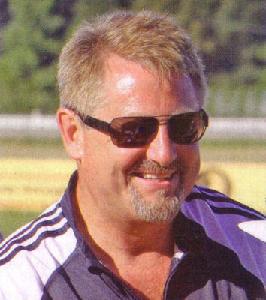 |
Hundreds of people attended the funeral service of Dave Carville which was held at Addington Raceway last Saturday afternoon. Dave died suddenly of a heart attack four days earlier, his wife Katie at his side. He was 55.
His passing came as a huge shock to all in the industry, because Dave was loved, respected and admired by everybody who knew him - whether on a personal or professional level, or both. He was as passionate about his family as he was about everything else that he adored and/or took part in...his land and his horses, harness racing in general, his and Katie's multi-faceted company International Cargo Express and subsequently ICE Bloodstock, his many friends, monthly card nights with the lads, and his not-so-occasional punts on races at the TAB.
Born in 1954, Dave grew up on a farm on the outskirts of Christchurch with sister Linda and brothers Barry and Allan. During his latter school years at Papanui High he played basketball, got involved in life saving, developed an interest in racing pigeons and there would always be a love for horses simmering away in the background too. After leaving school his work graduated from paper run to employment in the office of Blue Star Port Line. He eventually became the Office Manager before progressing on to manage LEP in the South Island, then forming his own business, International Cargo Express, in 1992.
The first horse Dave owned was called Genesis, a colt by Out To Win that he raced with a couple of mates, who won five races at two including the NZ Sapling Stakes; a race at three, and another four as a 4-year-old including the Rangiora Cup before he was sold overseas. Needless to say, he was hooked on the game from then onwards.
He and Katie continued to develop ICE, and today it is one of the largest freight-forwarding companies in New Zealand - one that was also instrumental in providing direct flights between here and Australia so that racehorses can get across the Tasman and back again much more easier; hence re-igniting true trans-tasman rivalry between our greatest horses, like in last year's NZ Cup.
Through their two branches of ICE plus the subsidiary companies ICE Perishables and ICE Bloodstock, Dave and Katie were always keen to keep supporting harness racing and putting money back into the game, as their sponsorship of various races, Addington Raceway's passing lane and ultimately our Annual Awards Function showed. Their generosity didn't stop there though, with other things they supported ranging from many local sports teams to a child in need of life-saving operation.
Over the years the Carvilles became just as devoted about breeding their own rachorses, and today there are numerous harness equines carrying the 'Ohoka'(colts and geldings) or 'Millwood'(fillies and mares) tags as part of their name - many of them highly successful. The couple's crowning glory in this respect was Ohoka Arizona, the 2006/7 2YO Pacer of the Year who won five of his eight starts as a juvenile including three Group events. Recently embarking on another campaign, Ohoka Arizona has won seven of 16 appearances and nearly $260,000 to date and has also been popular at stud, his first crop of foals being due any day soon. At last count Dave and Katie's list of weanlings, racehorses and broodmares numbered about 100, with 30 more foals expected on the ground in the next couple of months. Understandably, these will be downsized over the next year or so.
Dave is survived by his wife Katie and children Adam, Libby, Ashley and Paige - all of whom gave very emotional 'farewell' speeches to their father at last weekend's funeral. In a fitting finale to the service, a hearse carried Dave's casket and followed Ohoka Arizona for a couple of laps around Addington Raceway.
Credit: HRWeekly 29 Sep 2010
YEAR: 2010
PEOPLE
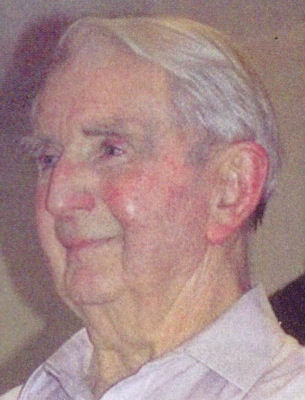 |
Peter Rennell rarely missed a race meeting at Addington Raceway and was renowned as the unofficial keeper of times and class records. Within seconds of a new class record being established on the track, Rennell would appear in the Press Room with past and present time details.
Rennell, who died age 82 last week, was a Life Member of the NZ Metropolitan Trotting Club, but he was foremost a Canterbury Park man and served on the club's committee until retiring in 1996. Earlier, he was involved in the administration of the Akaroa and Amberley clubs while they ran equalisator meetings.
He started work in the registration department of the NZ Trotting Conference, before going to Wrightsons and National Mortgage and Agencies. From 1975 to 1981 he was the New Zealand representative for Parramatta Livestock. Paul Davies, who worked with Rennell from 1970 until he left Wrightson-NMA, said he was "a great man for detail, compiling catalogues and keeping records to an exceptionally high standard. And he had a strong following amongst yearling sales breeders and vendors, assisting many in upgrading their stock."
Along with his wife Bev, he was a member of the Met Syndicate that raced the top pacer, Likmesiah. Rennell was the father of Harness Racing New Zealand's CEO, Edward Rennell.
Credit: HRWeekly 29 Sept 2010
| << PREVIOUS | 1 2 3 4 5 6 7 8 9 10 11 12 13 14 15 16 17 18 19 20 21 22 23 24 25 26 27 28 | NEXT >> |